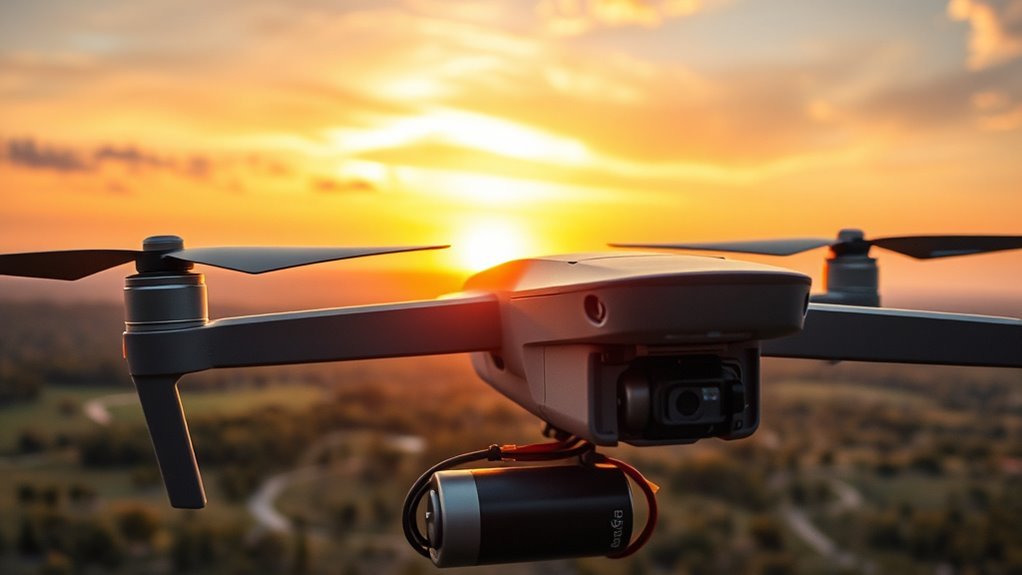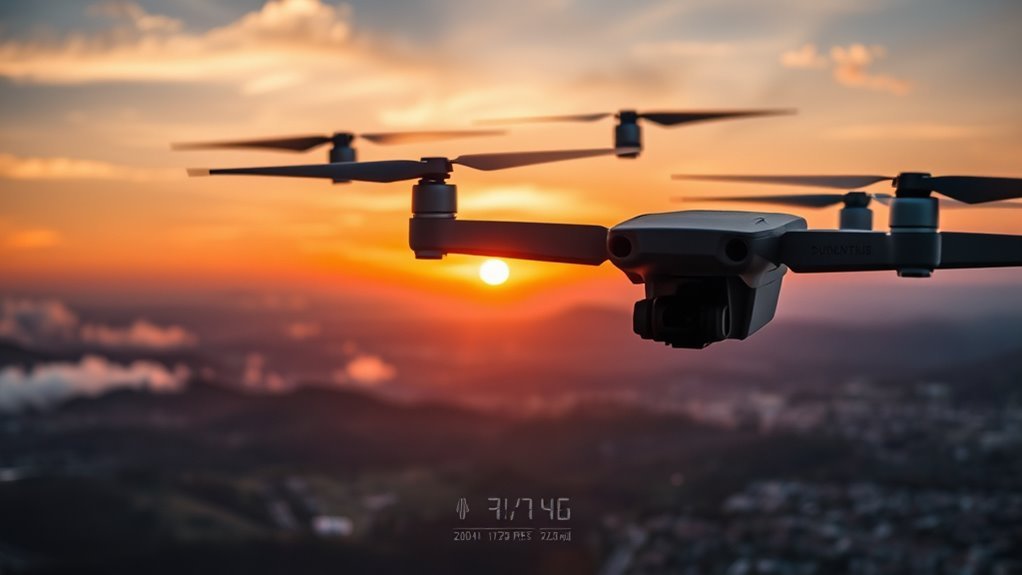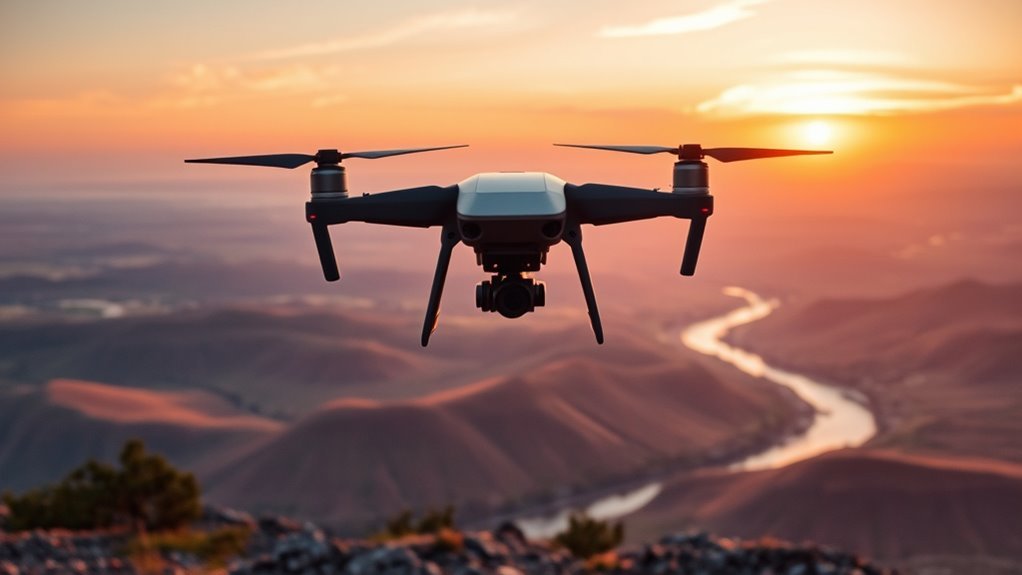Drone range is influenced by various factors, including battery life and capacity, propulsion system efficiency, and overall weight. You’ll find that flight modes and settings also play an essential role in determining range, as do communication technology and environmental conditions like altitude and terrain. Additionally, the drone’s design and aerodynamics greatly impact its performance. Understanding these elements can provide greater insight into maximizing your drone’s range and effectiveness. Explore further for more detailed insights.
Battery Life and Capacity

Battery life and capacity are critical factors determining a drone’s operational range. As you explore drone technology, you’ll find that battery chemistry advancements play a significant role in enhancing performance. Lithium-ion and lithium-polymer batteries, for instance, have seen remarkable energy density improvements, allowing drones to operate longer without increasing weight. This means you can achieve extended flight times, essential for missions requiring greater freedom of movement. The integration of these advanced batteries not only boosts your drone’s endurance but also enhances its overall efficiency. With ongoing research focused on next-generation materials, the potential for further advancements in battery technology promises even greater operational capabilities, enabling you to push the limits of your drone’s range and functionality in the field. Additionally, factors such as battery capacity and flight duration significantly impact how long a drone can remain airborne before needing to recharge. For example, the Amazon MK30 demonstrates optimized power usage with its impressive flight time of up to 30 minutes per charge.
Propulsion System Efficiency

When considering propulsion system efficiency, the type of motor you choose greatly impacts overall performance. It’s crucial to analyze how various motor types interact with battery performance factors to optimize range. Understanding these dynamics will help you make informed decisions for enhancing your drone’s operational capabilities. Additionally, selecting motors with a high power-to-weight ratio is essential for maximizing speed and efficiency during flight. The battery capacity not only influences flight time but also plays a significant role in determining the effectiveness of your propulsion system.
Motor Type Impact
Although various factors contribute to a drone’s overall range, the type of motor used in its propulsion system plays an essential role in determining efficiency. Motor efficiency and size directly impact how far you can fly, which is vital for your adventures. Consider these aspects when choosing your drone:
- Higher efficiency: A well-designed motor can convert more energy into thrust, extending your flight range.
- Optimal motor size: The right size balances weight and power, enhancing performance without sacrificing battery life.
- Freedom to explore: Efficient motors allow you to reach remote locations, giving you the freedom to discover new horizons.
Choosing the right motor can redefine your drone experience, ensuring you maximize every flight.
Battery Performance Factors
Power management is essential for optimizing drone flight, as the performance of the battery directly influences propulsion system efficiency. Understanding battery chemistry types, like LiPo and Li-Ion, helps in energy density comparison for longer flights. Advancements in charging technology reduce downtime, while effective heat dissipation methods prevent overheating, ensuring safety features integration. Additionally, cycle life effects can impact long-term performance, and voltage stability issues may arise under varying loads. A thorough discharge rates analysis reveals how quickly a battery can provide power without compromising efficiency.
| Factor | Impact on Efficiency | Considerations |
|---|---|---|
| Battery Chemistry Types | Determines energy density | LiPo vs. Li-Ion |
| Charging Technology | Affects downtime | Fast vs. standard charging |
| Heat Dissipation Methods | Influences performance | Passive vs. active cooling |
| Cycle Life Effects | Long-term reliability | Number of charge cycles |
Weight and Payload

When considering drone range, the weight of the drone itself greatly affects its performance. Your payload capacity directly influences how much additional weight you can carry, which in turn impacts flight duration and distance. Understanding these limitations is vital for optimizing your drone’s operational efficiency. Additionally, a balanced load can maximize energy consumption efficiency, allowing for longer flights with heavier payloads. Maintaining proper weight distribution is essential to ensure stability and prevent excessive power drain during flights.
Drone Weight Impact
The weight of a drone, including its payload, greatly influences its flight performance and operational range. When you consider drone materials and weight distribution, it’s clear that every gram counts. A heavier drone may struggle for altitude and stability, limiting your flight experience.
- Increased weight can lead to shorter flight times.
- Poor weight distribution affects maneuverability and control.
- Excess payload can compromise your drone’s efficiency.
Understanding these factors empowers you to make informed decisions about your drone setup. By carefully managing weight and selecting suitable materials, you can enhance your drone’s capabilities and truly enjoy the freedom of flight. Aim for a balance that maximizes performance while meeting your mission objectives.
Payload Capacity Limitations
Understanding payload capacity limitations is essential for maximizing your drone’s operational efficiency. Each drone has a specific weight threshold, which impacts flight time, stability, and overall performance. To make the most of your drone’s capabilities, you’ll need to implement effective payload enhancement strategies. This involves carefully selecting payload components and ensuring they align with your drone’s specifications. Conducting a weight distribution analysis is equally crucial; improper weight distribution can lead to a decrease in maneuverability and an increase in energy consumption. By balancing the payload and adhering to the drone’s limits, you can enhance flight efficiency and extend range. Ultimately, understanding these limitations empowers you to fully explore your drone’s potential while maintaining peak performance.
Flight Modes and Settings
While various flight modes and settings greatly influence a drone’s operational range, their impact often goes unnoticed by casual users. Understanding flight mode optimization is essential for maximizing your drone’s potential.
Flight mode optimization is key to unlocking your drone’s full potential and enhancing its performance.
- Different modes can drastically alter battery consumption. For example, flight efficiency can vary significantly between different drone models and their respective modes.
- Adjusting settings can enhance stability and control.
- Choosing the right mode can expand your exploration horizons.
- For instance, battery capacity plays a crucial role in determining how long your drone can stay airborne, affecting the range you can cover.
Communication Technology
Flight modes and settings may optimize a drone’s range, but communication technology plays a pivotal role in maintaining a reliable connection between the drone and the operator. The effectiveness of your drone’s operation largely depends on signal strength and data transmission capabilities. A robust communication system guarantees seamless control, even at extended distances. Understanding frequency bands is crucial for navigating legal limits and optimizing communication reliability. Additionally, ensuring NDAA compliance in component sourcing can enhance the overall reliability and security of communication systems in drones.
| Technology | Signal Strength | Data Transmission |
|---|---|---|
| RF Communication | High | Moderate |
| Wi-Fi | Moderate | High |
| 4G/5G Networks | Very High | Very High |
Choosing the right communication technology can greatly impact your drone’s operational range and reliability. By understanding these systems, you can enhance your flying experience and maximize your drone’s potential.
Environmental Conditions
When operating drones, you need to contemplate environmental conditions like wind speed and temperature. High winds can greatly reduce flight stability and range, while extreme temperatures may affect battery efficiency and overall performance. Understanding these factors is essential for optimizing your drone’s operational capabilities.
Wind Speed Impact
In the context of drone operations, wind speed considerably influences flight performance and effective range. High winds can create significant wind resistance, affecting your drone’s flight stability, and ultimately limiting its operational capabilities. Here’s how wind impacts your flight:
- Increased energy consumption, reducing flight time
- Potential for loss of control, risking damage or loss
- Limited ability to reach desired destinations, curtailing your freedom
Understanding these factors is essential for optimizing your drone’s usage. When flying in windy conditions, you’ll need to take into account the drone’s specifications and adjust your plans accordingly. Balancing the thrill of exploration with the realities of wind conditions guarantees you maintain control, allowing you to enjoy the freedom that drone flying offers without compromising safety or performance.
Temperature Effects
While wind speed plays a significant role in drone performance, temperature also has a major impact on operational efficiency. Cold weather can lead to significant battery performance degradation, causing reduced flight times and limiting your drone’s range. Temperature fluctuations can affect the viscosity of lubricants and the efficiency of electronic components, further complicating operations. In lower temperatures, batteries may experience a drop in voltage, which directly correlates to diminished power output. Additionally, the drone’s materials might become brittle, increasing the risk of structural failure. Understanding these effects is essential for maximizing your drone’s capabilities. Before launching, consider monitoring weather conditions to guarantee peak performance and to maintain the freedom of operation you desire.
Altitude and Terrain
Understanding how altitude and terrain influence drone range is essential for maximizing operational efficiency. The altitude impact on drone performance can be significant, as thinner air reduces lift and battery efficiency. Similarly, terrain influence affects flight paths and energy consumption. Here are some key considerations:
Altitude and terrain significantly affect drone range, impacting lift, battery efficiency, and energy consumption during flights.
- High altitudes can lead to reduced battery life and climbing challenges.
- Rugged landscapes may necessitate increased energy output, impacting overall range.
- Flat terrains generally allow for smoother operations, maximizing your drone’s capabilities. Moreover, the drone’s impressive hovering accuracy helps maintain stability in various conditions, enhancing its performance across different terrains.
Drone Design and Aerodynamics
When designing drones, aerodynamics plays a crucial role in determining their efficiency and range. You need to focus on shapes that minimize drag while maximizing lift, as this directly affects drone stability and overall performance. A well-crafted airframe with streamlined contours enhances aerodynamic efficiency, allowing your drone to glide smoothly through the air. Using lightweight materials can further improve performance, reducing energy consumption and extending flight time. Additionally, incorporating features like winglets can help reduce vortex drag, contributing to better stability during maneuvers. This is particularly important when considering flight performance and endurance, as it allows for longer operational ranges. Balancing these elements not only extends the range but also offers you the freedom to explore various applications, from photography to surveying, without the constant worry of battery life. Moreover, advanced flight stability techniques enhance the overall performance during challenging conditions, further optimizing your drone’s operational range.
Regulations and Restrictions
As you navigate the world of drone operations, it’s vital to reflect on the complex landscape of regulations and restrictions that govern their use. Understanding these legal frameworks can greatly impact your drone’s range and operational capabilities.
Navigating drone operations requires a keen awareness of regulations that shape your flying capabilities and safety.
Consider the following:
- Airspace restrictions can limit where you can fly, impacting your planning.
- Regulatory compliance is essential; failing to adhere can lead to fines or confiscation. Non-compliance with strict regulations can also result in serious penalties.
- Operational guidelines vary by region, influencing your flight paths and altitude.
- Being aware of legal boundaries surrounding drone operations is crucial to avoid conflicts and ensure safe flying.
To enjoy the freedom drone operation offers, you’ll need to stay informed and adapt to the ever-evolving regulatory environment. Balancing your desire for exploration with these constraints is key to maximizing your drone’s potential while ensuring safety and compliance.
Maintenance and Upkeep
While you might be enthusiastic to take to the skies, proper maintenance and upkeep of your drone are essential for ensuring ideal performance and longevity. Implementing preventive maintenance is vital; establish repair schedules to address wear and tear. Regular cleaning routines can prevent debris buildup, optimizing aerodynamic efficiency. Don’t overlook software updates, as they can enhance functionality and fix bugs that may affect performance. Follow inspection protocols to identify potential issues before they escalate. Adhering to usage guidelines tailored to your drone model will maximize component longevity. Finally, engage in performance monitoring to track metrics like battery health and flight stability, enabling you to make informed decisions that enhance your drone’s range and reliability. Additionally, payload management strategies are crucial, as they impact both the drone’s efficiency and battery life during operation.
Frequently Asked Questions
How Do Drone Materials Affect Overall Range Performance?
Drone materials greatly influence range performance through their construction and weight distribution. Lightweight components enhance efficiency, while ideal weight distribution guarantees stability, allowing you to maximize flight duration and achieve greater freedom in aerial exploration.
Can Weather Conditions Impact Drone Range Differently for Various Models?
Think of your drone as a ship steering through stormy seas; weather resistance greatly affects its journey. Different models handle wind impact variably, influencing overall range and performance, so choose wisely to embrace your aerial freedom.
What Role Does Pilot Experience Play in Maximizing Drone Range?
Pilot experience greatly influences drone range. Effective pilot training enhances flight techniques, allowing you to optimize energy management and navigate challenges, ultimately extending your drone’s operational limits and providing greater freedom in your aerial endeavors.
Are There Specific Brands Known for Superior Drone Range?
You might find that DJI’s dominance in the market often overshadows competitors, but range comparisons reveal brands like Autel and Parrot also excel. Each offers unique features that could enhance your drone’s operational distance considerably.
How Does Battery Brand Influence Drone Performance and Range?
Battery brand greatly influences drone performance and range. Brand reliability often correlates with battery chemistry, affecting efficiency, weight, and discharge rates. Choosing a trusted brand guarantees ideal power management, extending your drone’s flying capabilities and enhancing freedom in operation.

